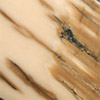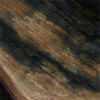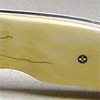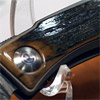Mammoth and Mastodon Ivory - Knife Handle Material
Mammoth Ivory Info

Description
For the purposes of this reference, Mammoth and Mastodon Ivory will refer to the tusks only of the Wooly Mammoth and Mastodon, there is a separate section for Mammoth and Mastodon Tooth as it has a different appearance. I've also kept a separate section for Elephant Ivory as it is different in appearance as well and now has import and export laws governing it's distribution.
The Wooly Mammoth is a ancestor of the modern elephant and has been extinct for thousands of years. Mastodons are slightly different and while they resemble Wooly Mammoths, have diferent jaw structures allowing them to eat leaves and overhead hanging plants, while Mammoths are strictly grazers. Their tusks have been collected and used for ornamental purposes such as knife handles, which we call Mammoth Ivory.
Ivory is made from dentin, which is 30% collagen and 70% inorganic material (mainly hydroxylapatite and some non-crystalline amorphous calcium phosphate), which is the same material that Mammoth Tooth and in fact all Mammal Teeth are made from. However, it is only Mammoth, Mastadon and Elephant Ivory that have the distinctive Schreger lines or cross-hatched pattern.
Mammoth Ivory is considered one of the rarest and most high-end materials for knife handles due to its rarity and ancient pedigree. Usually when used on knives a portion of darker brown material is seen along with some striations, which is the "bark" of the tusk.



